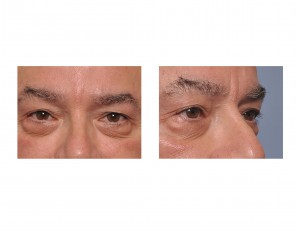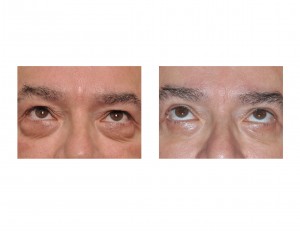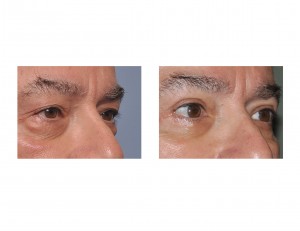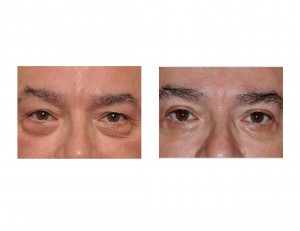Background: The eyes may be the window to the soul but there are also good indicators of how the face is aging externally. Aging first starts around the eyes and continues to progress as one gets older. This occurs because of the frequent motion of the eyelids and the orbicularis muscle that surrounds them. It develops quickly not only because of the muscle activity but also because the skin is thin and not very resistant to wrinkling and loss of elasticity.
The aging changes seen in the eyelids are classic with the development of excess eyelid skin and hooding, protruding lower eyelid fat and skin rolls and wrinkles that radiate outward in the crow’s feet area. These aging periorbital features are no different between men and women with the exception that men can develop more upper eyelid hooding due to thicker skin and more significant lower eyelid fat herniation.
While how the eyes age may not be gender different, when they appear for surgical correction frequently is. Men tend to appear much later in the aging process and at an older age. Thus their eyelid aging changes are frequently more advanced. Women tend to appear in the 40s and 50s when the eyelids aging is more moderate. Conversely, men appear more frequently in their 50s and 60s with more severe manifestations.
One of the great fears of men undergoing any facial rejuvenation surgery is that they will appear unnatural or have an operated look. They all seem to point to certain celebrities, such as Kenny Rogers, for how they do not want to look like after surgery. They are very interested to know how that postoperative look/problem is going to be avoided.



The key to a natural look in male blepharoplasty is to avoid over-resection of tissues, particularly skin. Too much skin removal creates a tight look and is prone to lower eyelid retraction. (ectropion) It is much better and more natural looking if there is still a few wrinkles left behind and a little aging present. This approach also lowers the risk of dry eyes in the older male patient who is at a greater risk for this problem.
Case Highlights:
1) Aging of the face first begins around the eyes and progresses eventually to upper eyelid hooding and herniated lower eyelid fat pads.
2) Men frequently delay eyelid rejuvenation surgery until the process is advanced with severe lower eyelid bags and very heavy upper eyelids.
3) Successful and natural-looking eyelid surgery in men avoids over-resection of tissues and a wide-eyed surprised look.
Dr. Barry Eppley
Indianapolis, Indiana



